Postcards from Southwestern France: Gazpacho or cold soup, Cassoulet, Albi, Moissac, Conques
We left Provence this week for a little trip to the Midi-Pyrénées in the southwestern part of France. We've been trying to save money by cooking at home most of the time since we started our nomadic existence in France (see previously; not that that's much of a hardship, since the produce and other foodstuffs in Provence are spectacular). But this week we've been staying in an apartment in a 17th century townhouse right around the corner from the Toulouse-Lautrec Museum in the heart of Albi, the capital of the Tarn Department. Since there are tons of great little restaurants here, we've been indulging ourselves a bit.
One thing I have noticed while eating out a lot more is that many places are serving little cups of what they usually call gazpacho, as an amuse bouche or as part of the entrée (appetizer). They are basically cold soups, made with various vegetables. I'm not sure this is a regional custom, but it is very nice regardless. Here's one we had the other day in the small medieval town of Moissac, as an amuse-bouche. It was basically a cold tomato juice, but very nice and refreshing.
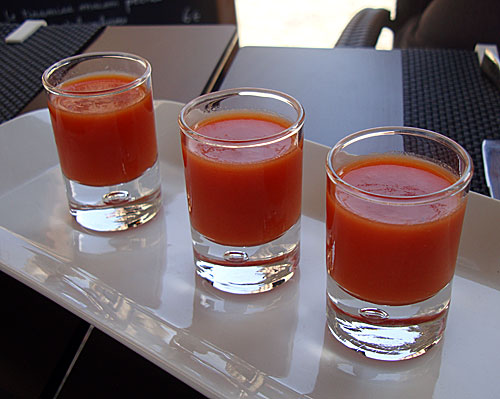
Here's another kind of gazpacho - a cold melon soup, served as an amuse bouche also. It was just pureed melon with nothing added I think.
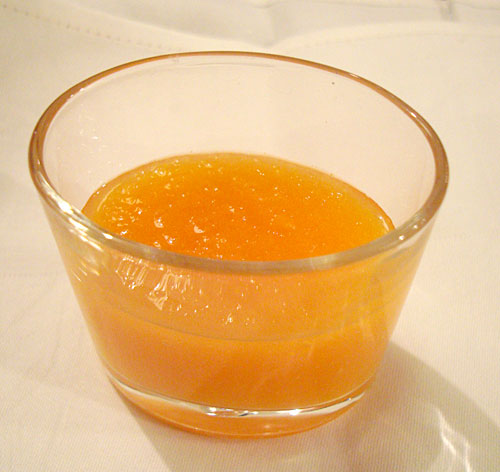
Here's another one, served as part of an entrée. This time it was a cold sweet pepper soup.
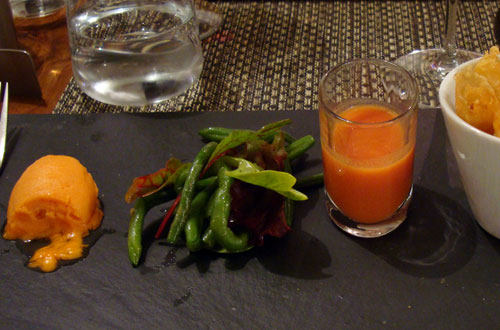
Here's a more classic gazpacho, made with tomatoes and cucumber, served in a tumbler. This was a full entrée portion.
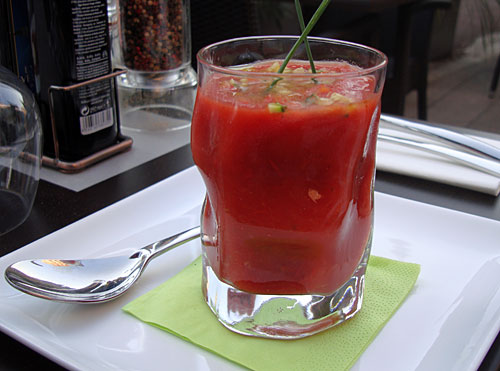
Finally, here's my favorite - it was merely described as a gazpacho des legumes (vegetable gazpacho). It was a cold vegetable soup; I tasted sweet corn, maybe carrot, celery, and so on. I know gazpacho purists may shake their heads, but it was really refreshing and delicious. It was one part of an amuse bouche - the other part was what you see on the spoon in the back, a piece of rough paté with a tiny bit of chutney. The combination was really nice.
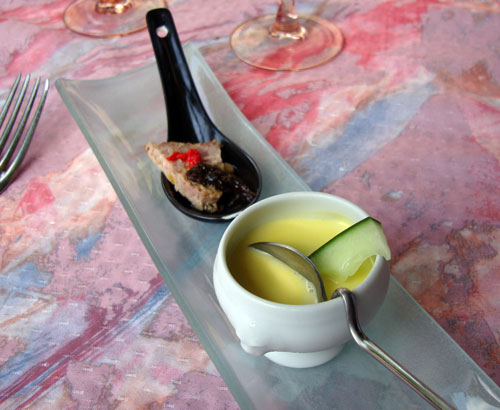
Once we get back 'home' to Provence, I think I am going to start more meals with a little cold soup of some kind. It's really a great start to a summer meal.
Cassoulet and more food from the region
The most famous regional dish is cassoulet, the hearty dish made of white beans and loads of hearty (fat!) meaty bits, such as duck, sausage, and - fat! I've had cassoulet elsewhere many times before, and made it myself, but the the way they make it here is really much better in my opinion. Here's a relatively light yet still rich version that we had at a restaurant with the adorable name of La Fourchet A Droite (The Fork (is) to the Right) in Albi. The abundance of fat just makes it unctuously creamy rather than greasy. I liked it so much, I've managed to have it twice so far...and am contemplating having it again for dinner tonight! (Actually cassoulet is supposed to have originated in the town of Castelnaudary, which is about an hour from Albi. I think I need to come back here when the weather is cooler and more conducive to enjoying piping hot bean-and-meat casseroles.)
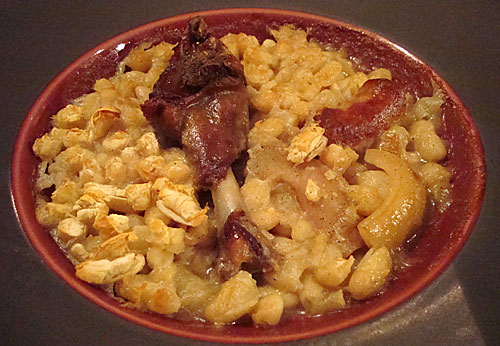
This is a Pastis Gascon, a speciality of the Gers region, also in the Midi Pyrénées. It's a pastry made of many layers of phyllo dough, and is filled with Armagnac-soaked and caramelized apple. I'm not sure I totally love it, but it is so pretty to look at.
I much preferred this pie though. It was filled with poached apricots and served with a sour cherry sauce and rich vanilla ice cream. Gorgeous! This was dessert at the meal that started with the gazpacho des legumes amuse bouche pictured above, at the Hotel Sainte Foy in Conques.
A little more Albi, plus Conques and Moissac
Albi is a fairly large town, but very mellow, and not crowded at all, even though it is the hometown of Henri de Toulouse-Lautrec and has a fine museum dedicated to him, not to mention a big, fortress like cathedral, beautiful riverside views, a quaint old town and more. The town is built of red brick, which is a gorgeous pink-rose color. Here it is in the early morning...
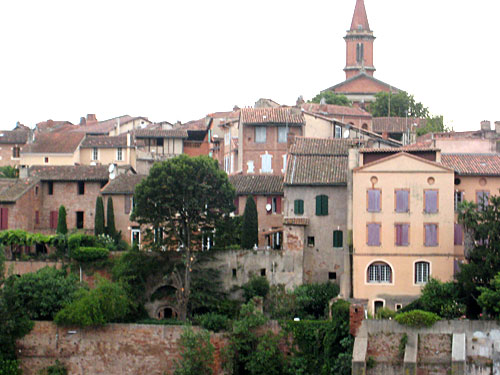
...and in the late afternoon...
Here's the inside of the large Marché Couvert (covered market) in the center of town. It has several produce stalls, a fish stall, bakeries and pastry shops, and a lot more. It may not be quite as awesome as the larger markets in Provence, but it's still quite good. We bought stuff from here for the meals that we ate in.
I loved this little store, called L'Artisan Pastellier. They sell clothing, accessories and other products made from the blue Pastel dye that was highly prized in Europe until indigo was imported from India. The blue is softer than indigo. They also sell art pastels, watercolor paints and other art supplies, mostly made with vegetable based dyes. Their web site.
We also made side trips to the medieval towns of Conques (that's a photo of Conques up at the top) and Moissac. One reason why I brought my mother here is because she's been rather obsessed by the pilgrimage routes to Santiago de Compostella, and Conques and Moissac were key stops. Both are beautiful places, though Conques is quite touristy. Moissac is a bit more relaxed I think. The Gothic cloister there is breathtaking.
If you'd like to see photos, they are all on my Flickr.
All in all, we really enjoyed our week here, even though the heat was stifling for much of it. (It felt a lot more humid than Provence, though that may just have been an anomaly.) I don't think I would choose to live here full time over Provence, but I think I'll try to come back here again in the cooler months - for, you guessed it, more cassoulet.
If you enjoyed this article, please consider becoming my patron via Patreon. ^_^

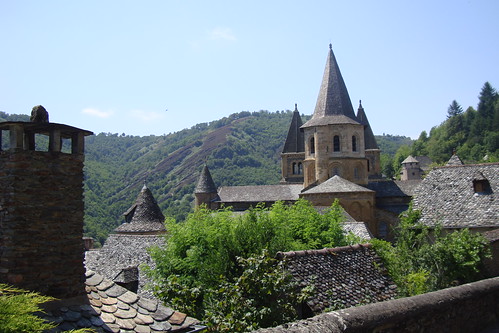
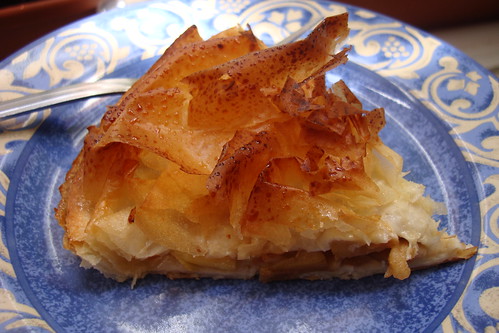
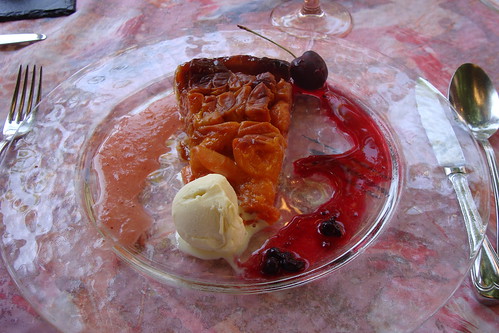
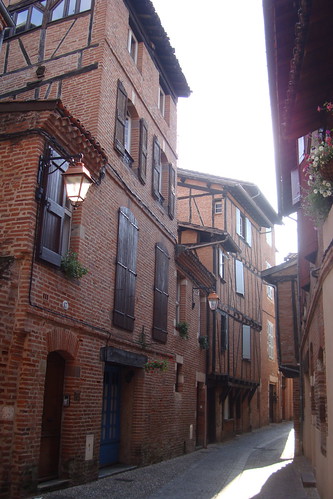
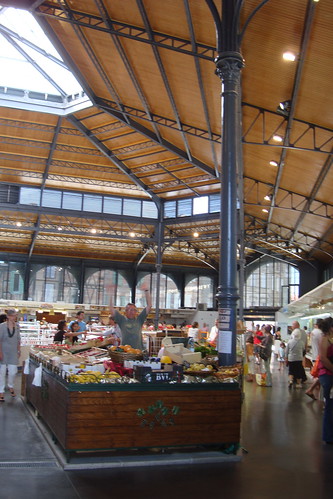
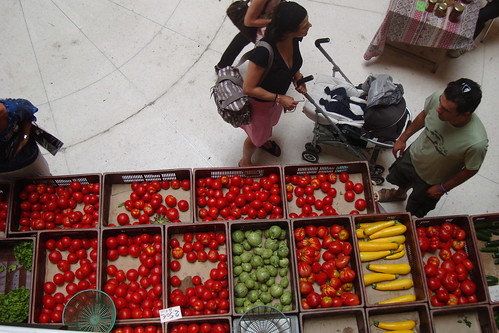
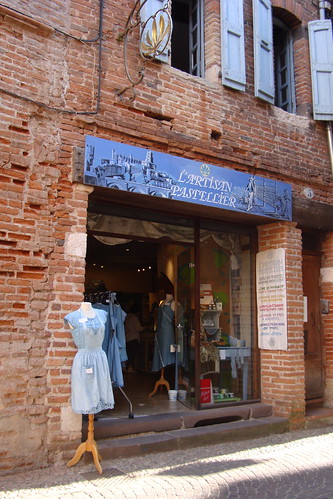

 Welcome to Just Hungry, where we serve authentic Japanese recipes and more! I'm
Welcome to Just Hungry, where we serve authentic Japanese recipes and more! I'm 















Comments
Chana Adar
17 July, 2009 - 21:25
Permalink
Re: Postcards from Southwestern France: Gazpacho or cold ...
Maki, it is very warm and humid here in nyc now, but cool in the green of The Park. I am enjoying all of the photos
from your trip to Albi. Especially the cold vegetable and melon soups, as I have come to enjoy them, too. I especialloy appreciated the simplicity of the ingredients, the absence of fussiness and the reliance on the goodness of the summer produce. - Chana
Zsuzsi H.
18 July, 2009 - 08:09
Permalink
Re: Woad Renaissance
What lovely pictures!
It seems the french blue dye is having a renaissance! Reading medieval novels, I never knew what "woad" was--until recently. It turns out, it's the english name for the french blue dye, Blue de Pastel.
There is another woad atelier about 75km sort of west from Moissac called Bleu de Pastel de Lectoure. I discovered them because they are coming to Vancouver, Canada as part of an amazing textile symposium in the Fall.
Juan
18 July, 2009 - 13:45
Permalink
Re: Postcards from Southwestern France: Gazpacho or cold ...
The gazpacho is a classical Spanish dish (right now I've got around two liters stored in my fridge) Its origins are roman or arab. It is typical from Andalucia, but you can get it almost anywhere (even in supermarkets) The original recipe is tomato-based with green and red peppers, onion, cucumber, vinegar, water, garlic, salt, bread and cumins.
yoruneko
18 July, 2009 - 15:18
Permalink
Re: Postcards from Southwestern France: Gazpacho or cold ...
My goodness Albi is my hometown, what a coincidence...
If you're in the area you have to go to Cordes-sur-ciel, it's a mere 20 minutes away from Albi. It's Myazaki's Castle in the sky, but for real.
Gosh I wish I was there I would have given you a tour!! I'm going back next week on holiday though but it will probably be too late :(
Sarah of Get Cooking
19 July, 2009 - 00:12
Permalink
Re: Postcards from Southwestern France: Gazpacho or cold ...
I saw that first picture and knew exactly where you'd gone, I've been obsessed with that site for year! Thanks for the photos, I wish I could head there myself right now.
Those gazpachos all look so vibrant and tasty, definitely perfect for summer. Thanks for sharing this little taste of France.
maki
19 July, 2009 - 09:52
Permalink
Re: Postcards from Southwestern France: Gazpacho or cold ...
Such wonderful comments - thank you! Zsuzsi I thought about going to that other store, but ran out of time...next time I will go for sure! Yoruneko we're already out of the area :( and you're the 3rd person to say to us that we should have gone to Cordes. Sarah, Conques is definitely worth going to!
Loretta
19 July, 2009 - 20:46
Permalink
Re: Postcards from Southwestern France: Gazpacho or cold ...
I'm not sure if it's even possible to be a gazpacho purist. There must be hundreds of recipes and variations and the original gazpachos never had any tomato, it being introduced so recently. There's a celebrated gazpacho today which is still consumed in Granada based on cucumber with no tomato at all.
A gazpacho doesn't even have to be a cold soup, or a soup at all. As well as the famous Gazpacho Manchego (more like a meat stew with unleavened bread - kind of like Matza but called Tortas Cenceñas - which is used like pasta) I've had 'conventional' salads laced with ice cubes which were presented to me as gazpacho.
Gazpacho is kind of meaningless as a description so, to me, it seems completely appropriate that the word has been appropriated by the French for these appetisers.
Now, if they were to do the same with rice dishes and called them paellas... that would be something else entirely!
Jorge
20 July, 2009 - 12:15
Permalink
Re: Postcards from Southwestern France: Gazpacho or cold ...
In Spain we would rather call gazpacho a liquid salad than a cold soup, for the reason that it is not cooked at all, just mixed.
In Andalusia, where gazpacho comes from, although recipes vary a lot, (and of course the best is always everyone's mom's ;-) essential ingredients are basically those described by Juan. You may discuss onions or cumins, but never tomatos or that it is served cold. Of course there can be creative recipes that you call gazpacho in the same way you can find so called cod carpaccio, but I think this is just a common trend in modern cuisine.
Gazpacho manchego is a diiferent dish with the same name. My mother comes from La Mancha and when she prepares gazpacho always refers to the andalusian one. It is the same as with "tortilla". In Spain it is an egg omelet, while in Mexico is like bread out of maize.
And also important, pretty good gazpacho can be even bought in supermarkets in briks like those of juice (always refridgerated). Probably the most reknown brand is Alvalle, that although a bit pricy, is as good as you can find in many good restaurants, with the advantage that it is ready to use (just pour in a cup). It is just so easy and healthy! Check it out in your area, maybe they are exporting it.
Red
10 October, 2009 - 17:24
Permalink
Re: Postcards from Southwestern France: Gazpacho or cold ...
Wonder where one could find the cool spoon in the bowl of gazpacho des legumes you have pictured?
Loretta
11 December, 2009 - 11:23
Permalink
Re: Postcards from Southwestern France: Gazpacho or cold ...
I just found out about this book:
Gazpacho by Alberto Herráiz
And found out that the author has made a name for himself popularising Spanish cuisine in France.
http://www.amazon.fr/Toute-lann%C3%A9e-gaspacho-Alberto-Herraiz/dp/28484...
Toute l'année gaspacho
With recipes by Arzak and Adria this might help explain the boom in Gazpacho type recipes in France.
I'm not familiar with Alberto Herráiz, I just hope he's a better chef than José Andrés (who popularises Spanish cuisine in the US)